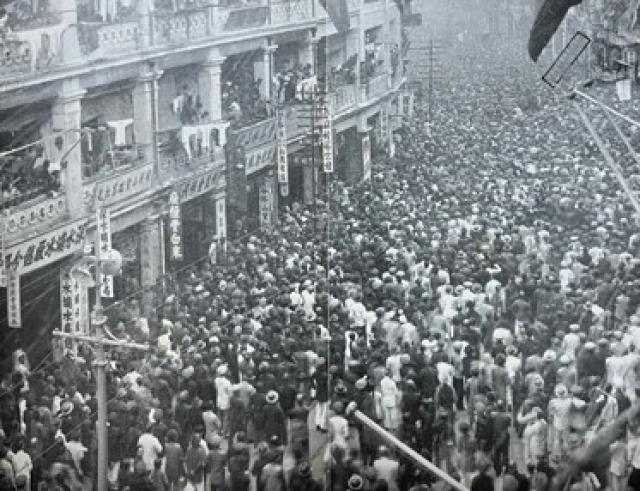Marking the March 1922 end to the Chinese Seaman’s Union inspired general strike.
The above photograph of an ‘historic moment’ reportedly shows jubilant, massed onlookers witnessing the restoration of the sign over the Chinese Seamen’s Union Headquarters, which had been taken down by government officials when, one month earlier, the colonial authorities had issued instructions to forcibly close down the union and arrest its leaders.
The pre-publication, hand-drawn rectangle that can be seen towards the upper right-hand corner of the image, to where the crowd’s attention appears to be drawn, presumably marks the location of the union office where the event is unfolding.
This fold-out photograph (measuring 22cms by 17cms) appears in the political pamphlet: Browder, Earl, Civil War in Nationalist China, Labor Unity Publishing Association, Chicago 1927.

Comments
1922 Seamen's Strike
Local HK newspaper reports about the Seamen’s strike of 1922 make for some very interesting reading about expatriates’ attitudes of the time. Many of Hong Kong’s British residents were indignant about local workers having followed the lead from workers in Canton and risen up demanding increases in salaries to a level which they needed to survive on.
Egged on by mean and greedy tycoons who were well represented in the Legislative Council, the forceful and over-confidant Governor, Reginald Edward Stubbs, showing no sympathy for workers genuine grievances about low pay, signed into law Emergency Regulations creating powers to censor all publications as well as telegrams sent overseas which might include inconvenient comment about the strike and the background to the workers’ demands . Not only this, but an added regulation created powers for various Government officials to order people to continue working ”if considered necessary by the said officials” and refusal to work could lead to immediate arrest and prosecution.
This led to heated debate back in UK’s Parliament where Winston Churchill, then serving as Secretary of State for the Colonies, was heckled with accusations that “enforced slave labour” was being practiced in Hong Kong. Shortly after this the Hong Kong Government did an abrupt policy U-turn and the banned Seamen’s Union was recognized once again. This was followed by negotiations with union representatives leading to an agreement for substantial wage increases. The Hong Kong government denied later that the backdown had been because of an intervention by the British Government but all bets are off on this as to whether the HK Government's denial of this was the truth.
"If we had only known"
As an anecdote to this story, the unmarried expats who like to spend their evenings and weekends propping up the bar counters in the many pubs and taverns found themselves in March without either food or booze, the catering staff having all done a runner during the strike. Only the Palace Hotel located at the junction of Hankow and Haiphong Road in Tsim Sha Tsui managed to remain open where proprietor Jimmie Oxberry’s wife boiled soup and cooked up hot meals while her husband aided by manager “Spud” Murphy took their coats off to keep the beer flowing during the entire strike.
Two days earlier than the China Mail's story "How the Palace Hotel Weathered the Storm" the proprietors had paid for an advertising insert in the newpaper. A hundred years later this is still a common business tactic in the world of advertsiing whereby a customer who has paid for an advert gets a free plug for his busisness in the form of a short story in the same publication .